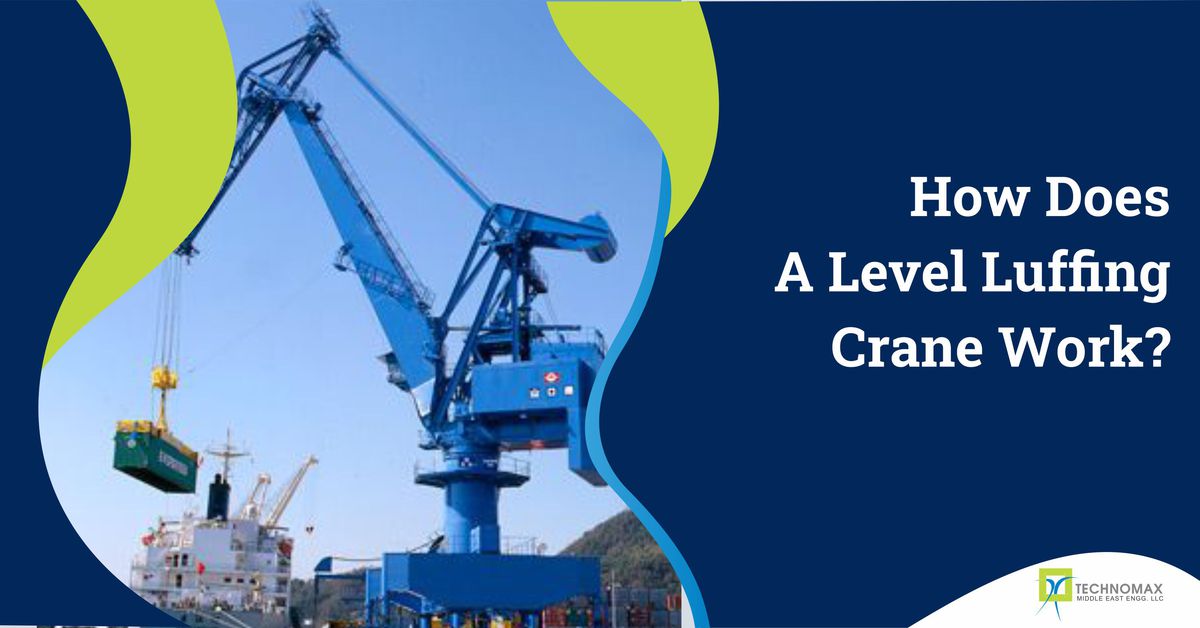
Introduction
It's incredible to see all the various types of heavy equipment and tools being used on a construction site. A crane with its boom or mast up in the air bearing or raising a load is frequently the first thing you encounter. If you are new to the market or a seasoned pro, there's a fair chance you have come across crane equipment you had never seen before or used a crane word you have never heard before. Read more about Level Luffing Crane.
Different types of cranes are used in construction, depending on the form of operation. When considering crane installation, it is necessary to understand the different types of cranes, one of which is a level luffing crane.
What is a Level Luffing Crane?
A level-luffing crane has a hook that stays at the same level when luffing; the Crane jib is moved up and down to drive the hook inwards and outwards relative to the base. When the careful movement of a load near ground level is necessary, such as in construction or shipbuilding, level-luffing is critical. A luffing tower crane is suitable for construction projects with limited space on either part of the site and the need for safety.
The way a level luffing tower crane functions is peculiar. To pass the load, the pivots of its horse-head jib join together and then flex up and in, or down and out. When the crane luffs, it swings horizontally rather than vertically to hold the hook at the same position.
Features of a level luffing crane
Some of the characteristics of a level luffing crane include-
- For worksite productivity and cost savings, intelligent, modular designs for fast cycle times with easier erection, disassembly, and transportation of the level luffing crane are available.
- With a built-in encoder for Overspeed safety and a load measurement device for high hoisting speeds while working with a light load and an empty hook.
- Low-maintenance architecture with modern safety features, including the ability to add anti-collision and zoning systems and CCTV cameras.
- Operator cabs that are comfortable and simple to use, with climate controls, flexible seating, and easy-to-read display screens. In addition, step-less motor operation of the trolley and hoist is available in these cabs, allowing the load to creep more slowly.
- Genuine, premium-quality parts that have been proven to be high-quality and long-lasting for continuous heavy use in any form of a working environment.
Advantages of a level luffing crane
When should consider level luffing crane installation because of the advantages that it offers:
- Luffing cranes (crane installation) have helped solve many inner-city construction issues when it comes to the battle for valuable space in and around a construction site. The jib can be lifted standing vertically in the air at a minimum of a 5m radius from the mass section thanks to the luffing crane's design. The flat-top crane, on the other hand, must be held parallel to the project and at the pre-determined defined radius of the jib.
- This has resolved many problems for projects in cities worldwide where obtaining oversailing rights is either impossible or extremely difficult. If the loads being carried by the crane must be brought over the top of a neighboring building that is public, government, or has a large population of the general public, such as public transportation stations, these rights are generally not granted. The luffing crane installation keeps the jib and the load within the construction site's limits at all times, ensuring the public's safety.
- Using luffing-jib cranes as auxiliary cranes to primary tower cranes will increase material handling cycles on the job site, minimising construction time.
- Local regulations in some areas necessitate the use of luffing-jib cranes installation. For example, cranes cannot fly over surrounding spaces while operating on a job site in London. Luffing jib crane installations are in high demand because they can lift the jib from a horizontal to a completely vertical position.
How does a level luffing crane work?
A level luffing crane can be operated in various ways, but the mechanical method is the easiest. When you look at the geometry of a crane installation like this, you'll notice that the parts form a parallelogram. It's easy to figure out how it works once you realise this. This is quite similar to the parallel linkage used in early Victorian beam-style steam engines. Other level luffing cranes can be made by manipulating the rope artificially, either electronically or hydraulically. To luff means to lift a load by moving a crane's jib vertically. A luffing jib shift with a load or into a working angle to lift a load under control (hydraulic or cable).
At ground level, manually fixed offsets are set. The boom is lowered, and the pins that hold the offset's vertical movement in place are removed. After that, the boom is slowly raised until the desired angle and pinning can be achieved. This procedure must be repeated to adjust the offset angle. These are time-consuming and physically demanding operations. Re-pinning from the top of a ladder can be difficult at extreme offset angles and long extensions touching the boom head. There is no such job with the hydraulic jib.
If mounted, the operator can luff the jib with load from the cab, for example, on some Grove telescopic cranes, from 5° to 40°. Because of the variety of lifts available, the versatility that allows for adjustments in the middle of a lift, and the lack of setup time, the operator can focus on what matters most.
Conclusion
Luffing jibs are flexible tower crane installations that can be used on any construction site. They're handy on smaller sites where oversailing or multiple cranes are needed. If you are looking for crane installation in Abu Dabhi, you should understand the different kinds of construction cranes, and level luffing crane installation are one of them. This guide gives an idea of how the level luffing cranes work and the advantages it has.
Learn More About Our Services

Recent Blogs

Get Started Now!
It takes less than a minute of your time. Or you may simply call +971 2 555 1 783






